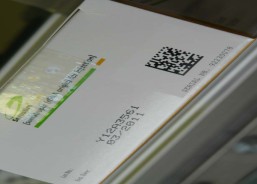Merck Serono sees France's CIP13 as stepping stone to EU serialisation
Phil Taylor, 12-Mar-2010
 Merck Serono is one of only a handful of drugmakers who have set up a full track-and-trace system in the USA, and is now looking to draw on this expertise for new coding programmes in Europe.
Merck Serono is one of only a handful of drugmakers who have set up a full track-and-trace system in the USA, and is now looking to draw on this expertise for new coding programmes in Europe.
The company was an early adopter of track-and-trace because of diversion problems it experienced with diversion and counterfeiting of its human growth hormone product Serostim (somatropin) in the 1990s, according to Sebastien Mauel, Merck Serono's head of product security.
Now, the firm has decided to implement a coding system in Europe that will initially cater for France's soon-to-be-introduced CIP13 coding requirements but will be fully upgradeable to a full serialisation system in future, said Mauel at the recent IQPC conference on Pharmaceutical Anti-Counterfeiting in Amsterdam, the Netherlands.
The CIP13 requirements are that by December 31 this year all pharmaceutical products in France will have to carry a datamatrix barcode incorporating the CIP13 code (which is not serialised or randomised), the batch number and expiration date.
Merck Serono says it intends to equip all its manufacturing lines with the same technology and make sure that it is flexible enough to implement full serialisation regardless of specific national requirements.
The company is currently working to implement the coding technology at six production facilities across six countries, said Mauel, with the 2D datamatrix code applied via in-line printing during production.
US experience
Merck Serono set up one of the industry's first track-and-trace systems in the USA back in 2002 and is convinced of the benefits that a full serialisation programme can deliver.
At the time, Serostim - the only drug approved for the treatment of wasting associated with HIV infection - had found a ready black market among groups such as bodybuilders because of its anabolic properties.
As there is often a correlation between HIV infection and drug abuse, the company realised that some patients were selling their Serostim in order to finance their drug habits, and counterfeit versions of the product were also in circulation.
The solution was a restricted distribution system for Serostim which included an individualised identification number for each pack via a randomised, seven-digit serial number - carried via a linear barcode - that was scanned and logged at the point of dispensing. The technology behind the system was supplied by SupplyScape and Siemens.
Meanwhile, dispensing of the product was also limited to a closed network of just 300 pharmacies across the USA, with Serostim packs tracked from the manufacturer, via the distributor, to the pharmacy.
The result was that by 2005 there were no cases of counterfeits identified in the supply chain, Mauel told the meeting. And with this groundwork done the decision was taken in 2007 to upgrade the system to a 2D datamatrix system that would conform to the California e-Pedigree proposals, since postponed to 2015.
Mauel told SecuringPharma.com that the company is also considering extending the system to include additional products in its portfolio, although no decisions have been taken as yet, given that the US Food and Drug Administration is due to publish guidance on track-and-trace later this month.
However, he added that "we need to change the state of mind of people in the industry so that they focus on the benefits of serialisation, not on mere compliance with regulations."
"Increased visibility means better inventory management, better insight into demand patterns, easier detection of expired products, more efficient recalls, less opportunities for fraudulent activity, and of course better patient safety," he concluded.

©
SecuringIndustry.com




 Merck Serono is one of only a handful of drugmakers who have set up a full track-and-trace system in the USA, and is now looking to draw on this expertise for new coding programmes in Europe.
Merck Serono is one of only a handful of drugmakers who have set up a full track-and-trace system in the USA, and is now looking to draw on this expertise for new coding programmes in Europe.